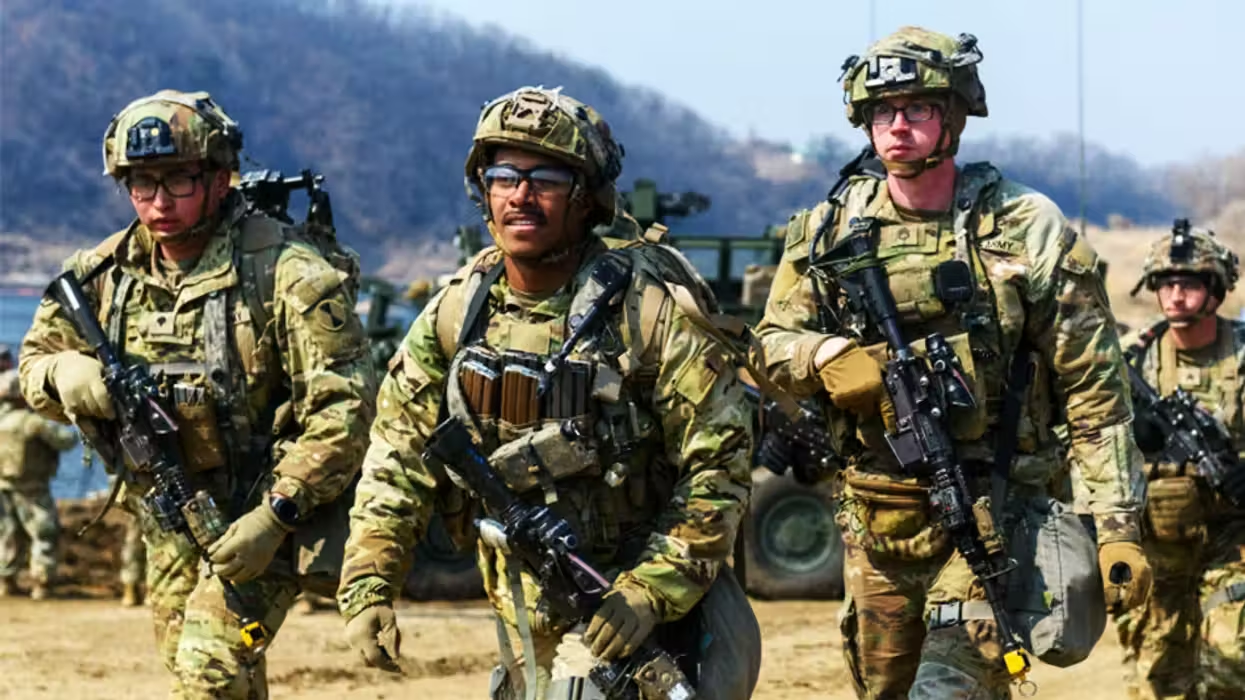
© 2025 Blaze Media LLC. All rights reserved.
Basically a flying artillery battery.
We live in an age when people say our military can shoot a missile down a chimney. But in the war on terror, sometimes what you really need is just a few huge guns to unleash massive firepower anywhere on the battlefield, at any time.
With that in mind, today the Blaze gives props to the AC-130 Gunship.
Between the AC-130 and the A-10 Warthog, the U.S. military has the most formidable close-air support capabilities in the world. While the A-10 is a battle-tested, tank-killing bruiser, the AC-130 models can offer total battlefield dominance to our soldiers on the ground.
Surprisingly, the AC-130's heritage is that of a cargo plane, not a fighter or a bomber. The Vietnam-era predecessor to the AC-130 is the Hercules transport plane. The airframe is manufactured by Lockheed, but Boeing arms it up to make the AC-130 an aerial offensive powerhouse. Its primary mission is close air support, but the AC-130 also takes on armed reconnaissance and air interdiction roles.
The two main variants in action today are the Air Force's AC-130H Spectre and the AC-130U Spooky. Both planes fall into the AC-130 gunship family, though the Spooky is the 3rd generation model and is almost double the price of the Spectre at $210 million.
When it comes to armaments, the AC-130 is basically a flying artillery battery. Its most common weapons configuration has three main guns over varying sizes, each one bringing a different option to the fight.
The GAU-12/U Equalizer gatling-style gun can fire 3600 rounds per minute and completely saturate an area. Some operators have claimed "it can put a round on every inch of a football field." If our Rangers or Marines run into trouble, whether it's an urban fight in Mosul or a mountain pass in Kandahar, a "Spooky" or "Spectre" can rain down the fury with this versatile anti-personnel weapon.
If the enemy has some vehicles in the mix, then the AC-130's mid-size weapon-- a 30 mm Bushmaster cannon-- would come in handy with its 200 rounds per minute rate of fire. Older models had 25 mm or 40 mm cannons, but they have been phased out in favor of the 30.
And if the bad guys are really dug-in, "Spooky" can pound fortifications with its 105 mm howitzer. That's right-- the AC-130 lugs around a heavy artillery piece up in the sky, points it at the ground, and tears it up.
The Spectre and Spooky models both have advanced electronic and navigation equipment upgrades from the earlier C-130 models. The Air Force describes the electronics package as follows:
"The sensor suite consists of a television sensor, infrared sensor and radar... to visually or electronically identify friendly ground forces and targets...and employs a synthetic aperture strike radar for long-range and adverse weather target detection and identification. The AC-130's navigational devices include inertial navigation systems and global positioning systems."
The AC-130's defenses are formidable, too. As the weapons are port-side facing, the AC-130 flies a continuous loiter loop around its target, which makes it susceptible to ground fire and surface-to-air missiles. Fortunately, the AC-130 has that threat covered too with an array of countermeasures, including this flare dispersal shown in the video below:
To sum it up, here is a live fire exercise with an AC-130 that gives a good overview of its characteristics and capabilities. Note the distinctive "ripping" sound it makes as the gunship lays down suppressive fire. Airboyd.tv provides the video:
Want to leave a tip?
We answer to you. Help keep our content free of advertisers and big tech censorship by leaving a tip today.
Want to join the conversation?
Already a subscriber?
more stories
Sign up for the Blaze newsletter
By signing up, you agree to our Privacy Policy and Terms of Use, and agree to receive content that may sometimes include advertisements. You may opt out at any time.
Related Content
© 2025 Blaze Media LLC. All rights reserved.
Get the stories that matter most delivered directly to your inbox.
By signing up, you agree to our Privacy Policy and Terms of Use, and agree to receive content that may sometimes include advertisements. You may opt out at any time.







